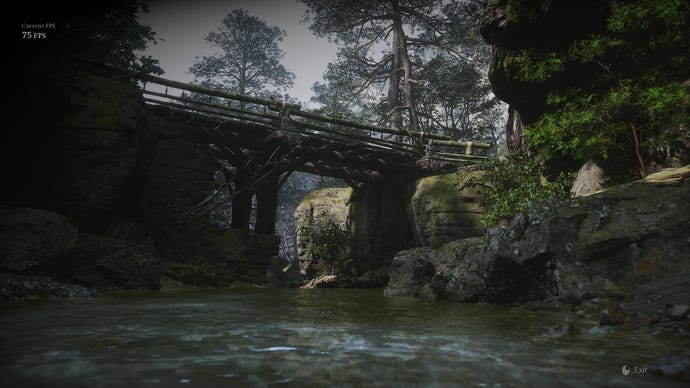Let’s beat some usefulness out that Black Myth: Wukong benchmark tool
Unlike Ed, I wasn’t deemed important or youthfully handsome enough to get Black Myth: Wukong review code, leaving my only hopes of conducting some hardwarey performance investigation with the recently released benchmarking tool. The one that, by the admission of developers Game Science themselves, “may not fully represent the actual gaming experience and final performance at the time of the game’s release”. Monkey nuts.
The tool does allow for tinkering with individual graphics settings, as well as fancier tricks like ray tracing and both DLSS 3 and FSR 3.1 flavours of frame generation. But considering Wukong is a fighting-forward Soulslike, the benchmark process is remarkably subdued, largely trundling down a quiet river with only brief glimpses of idling NPCs. There’s no way to judge, say, how a storm of boss-fight particle effects might tax a GPU, nor what would happen if you ignored the system requirements’ SSD stipulation and tried playing off an old hard drive.
However, I still think there’s some value to extract from this peaceful forest flyby. For one thing, it’s encouraging for Wukong’s chances on the Steam Deck: I got 65fps on the Valve handheld, with a combination of the Low preset and FSR upscaling set to 66%. Even if the tool isn’t perfectly 1:1 with the full game’s launch performance, it would have to be obscenely off-course to deny the Deck a smooth time.
More broadly, the tool can also provide a glimpse into which specific settings will be worth lowering, should you want slicker performance than what the presets offer. Even if the benchmark isn’t the best demonstration of, say, visual effects, if you can get big framerate gains from dropping something that is heavily represented – shadows, textures, reflections and so on – then it’s still a good bet that reducing those same settings will help speed up the full game.
To find out which options claimed the biggest performance impact, I started with an average of 36fps – that’s on the RTX 4060, at 1080p, using the highest Cinematic preset with DLSS at 75% – and re-ran the benchmark after changing each one individually. Here’s the results:
| Setting | Average performance |
|---|---|
| Motion blur, Strong to Off | 36fps |
| Super resolution sampling, DLSS to TSR | 32fps |
| Super resolution sampling, DLSS to FSR | 34fps |
| Frame generation, Off to On | 60fps |
| Full ray tracing, Off to Medium | 38fps |
| View distance quality, Cinematic to Medium | 37fps |
| Anti-aliasing quality, Cinematic to Medium | 37fps |
| Post-effects quality, Cinematic to Medium | 37fps |
| Shadow quality, Cinematic to Medium | 51fps |
| Texture quality. Cinematic to Medium | 36fps |
| Visual effect quality, Cinematic to Medium | 39fps |
| Hair quality, Cinematic to Medium | 38fps |
| Vegetation quality, Cinematic to Medium | 40fps |
| Global illumination quality, Cinematic to Medium | 45fps |
| Reflection quality, Cinematic to Medium | 37fps |
Sticking with just the quality settings for a moment, we can see that shadows, vegeation, and global illumination are the biggest framerate hogs of the bunch, and are therefore probable candidates for lowering in the full game. With all three on Medium at once, the rest remaining on Cinematic, my RTX 4060 put in a far smoother 75fps average. Obviously that exact figure could go up or down a bit in Wukong proper, but it’s very likely that those three settings will still present the biggest challenge to your rig.
Going into the more high-tech gubbins, DLSS looks like (once again) the best upscaling option, though if you don’t have a compatible RTX graphics card for it, neither TSR or nor FSR are especially ugly alternatives. It’s also interesting how enabling ray tracing can slightly improve performance over the Cinematic preset; normally RT effects are the GPU-heaviest things in the menu. Wukong being an Unreal Engine 5 game, it’s using Epic’s Lumen tech for its highest shadows and global illumination settings, and this can go just as hard as regular ray tracing on your GPU. If not more so, evidently. Opting for full ray tracing (or path tracing, as it’s often called) seemingly replaces those Lumen effects, hence the minor performance bump.

So, the Black Myth: Wukong benchmark: not as pointless as it looks. I still wouldn’t assume that a solid 60fps in the tool equates to a solid 60fps in the final game, but once the latter releases on August 20th, at least you can go into it knowing which settings to cut if performance gets dicey.

